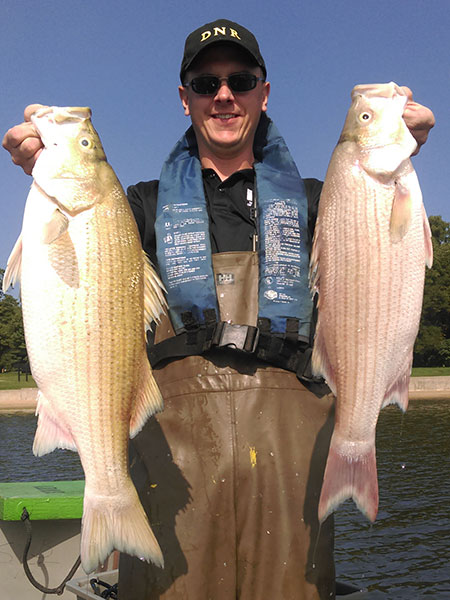By Louie Stout
 Potato Creek ‘Wipers’ Deserve More Attention from Michiana Anglers
Potato Creek ‘Wipers’ Deserve More Attention from Michiana Anglers
Unless you’ve had a rod ripped into the water while fishing off the bank or had something destroy your crappie rig, you may not know there’s a pretty cool – and big - fish swimming at Worster Lake.
The hybrid striped bass – also known as a wiper – has been stocked in the Potato Creek State Park for eight years but darn few anglers fish for them.
A few of the fish get caught, but usually by unsuspecting anglers targeting other fish. When you hook a big one, you’ll know it; they are aggressive biters, hard-pullers and make good table fare when grilled, broiled or baked.
The “wiper” is a cross between a white bass and a freshwater striped bass but doesn’t reproduce. White bass usually don’t get bigger than a couple of pounds while the striper gets to 50 pounds or bigger.
The white bass is an aggressive bugger, striking small lures or live bait as if it hasn’t eaten in week. Stripers are a little more finicky, but will hit lures.
Biologists created the hybrid striped bass to provide a more aggressive striper-like fish that may not get as big as the full-blooded type but will grow to some impressive sizes. The Indiana record is 22 pounds, 2 ounces, caught from the Tippecanoe River in Carroll County.
The fish are stocked annually in June as 1½ inch fingerlings but can reach 13 inches in their first year and grow to 18 inches within three to four years. Worster received 3,270 fish last month.
Indiana also stocked at Nyona Lake in Fulton County and Shafer and Freeman in White County as well as a handful of southern Indiana lakes.
They were put in Worster Lake to help control the over-population of gizzard shad and appear to be doing just that.
“When we surveyed Worster in 2012 we caught only 16 wipers,” said District Fisheries Biologist Tom Bacula. “In 2016, we caught 38 up to 23 inches. They are surviving well and growing fast.”
The wipers are eating machines, feasting on the abundant shad in Worster. Shad are not a gamefish nor are they native to the lake. They reproduce often, and while the little guys provide food for crappie and bass, they grow quickly to sizes so large that the native gamefish can’t feast on them.
As a result, a lake becomes overrun with shad that compete with bluegill and other game species for the tiny organisms that the younger, more popular fish need to survive and grow properly.
“The bluegill are benefiting from the wipers,” said Bacula. “Before we stocked them, we rarely saw 8 inchers. Now we’re seeing more of the bigger gills.”
Some anglers voice concern the wipers “hurt” bluegill populations, but Bacula disagrees.
“Worster has a ton of small bluegill so any extra predation is a good thing,” he said.
In addition to the biological benefits wipers provide, they also give anglers a trophy fish to target.
However, because their innate nature is unlike most warm water native fish, catching them requires different tactics. They are more of a pelagic fish, meaning they roam in groups offshore, following the schools of shad. They will venture near shore occasionally, usually to push baitfish against the bank, but spend most of their time hovering in deeper water.
Since no one in this area appears to have figured out the Worster wipers, I contacted Bill Carson, field promotions manager for Humminbird in Georgia, an avid striped bass angler.
He says casting Umbrella rigs (wire contraptions with multiple swimbaits tied to each wire) is the best way to catch them.
“Small bucktail jigs, crankbaits and even crappie jigs will get them to bite,” he said. “They’ll even take crappie minnows.”
Large topwater lures, like the Zara Spook or other walking baits, will draw vicious strikes when the fish are near the surface. Keep that in mind if you see wipers busting shad near a shoreline you are fishing.
A sonar (fishfinder) unit is the best way to locate hybrids when fishing from a boat. Watch for wads of shad and big marks lurking beneath and around them.
Once located, try trolling through the school or casting with baits that run just above the depth level they are using.
“Wipers like to follow the creek channel and will linger where two channels come together or even hover over brush piles,” Carson said. “But they also can be caught around something made of concrete, be it a boat launch or riprap (rocks) along the shore.”
Indiana’s bag limit is 12 but no more than two may measure longer than 17 inches. There is no minimum size limit.


